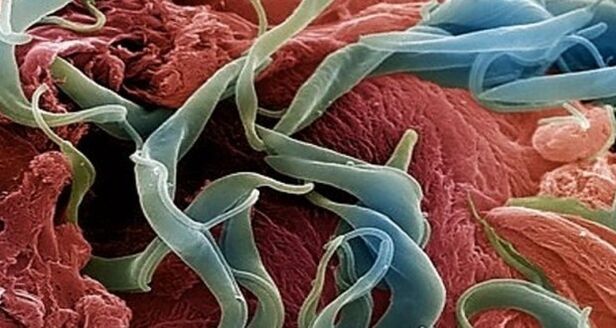
People and animals are attacked by these creatures, the infection is easily transmitted to one another through infected products, water and dirty hands.The appearance of parasites in the body will help prevent the rules of prevention and careful observance of personal hygiene, but these measures do not guarantee one hundred percent protection.Helminants living in the human body can live in different organs, vary in appearance, size, and degree of damage done to a person.
Parasites in the human body
How many situations are when a person walks around doctors for years and cannot escape allergies, treat asthma, drink sugar drugs and all no avail?Each of us has such recognitions that spent large quantities in the treatment of various diseases and received no results.
Only in rare cases, when the doctor is either very smart or very responsible, does he direct such a patient to a regular analysis of the feces and then ... then the parasites are found in the human body, which cause dozens of diseases, and with which no one fights in the treatment of these pathologies.
Despite the determined opinion, worms are not necessarily "defined" in the intestines and can be detected by a banal feces analysis.Many parasites feel great in the lungs, hearts, muscles, and even in the brain and eyes.
The well -known malaria, which was once defeated, has returned again and this is the most dangerous parasitic disease in the opinion of experts.Malarial plasmodium lives exclusively in the blood and not every doctor will be able to recognize this disease with sufficient confidence.
How the parasites fall into the human body
They fall into the human body in different ways, most often this is due to the use of infected water and food.
Grape eggs remain stable for up to 6 months and through toys, carpets, underwear and pastel linen enter the body.Ascarid eggs come to us inside through poorly washed vegetables and fruits.Barbecue or high home is a 95% guarantee of trichinellosis infection.
The parasites penetrate inside us with insect bites, when washing in freshwater reservoirs, through air, dusty, which is an egg carrier.
Salt fish, stroganine or caviar are the cause of tape -worm infection, the length of which reaches 12 meters and which can live in your body under 25 years.Cases of infant infection have become more frequent in the parasites in the abdomen.Dogs and cats, through their humid breathing, can spread the parasite eggs at a distance of up to 5 meters.
You can become infected through the dirty hands, not only theirs, but also the sellers, chefs, waitresses, parasites travel with money and parcel of public transport.A high concentration of parasite eggs is observed in products, such as: bacon, smoked sausage, bacon, sausage, pork with any shape, beef, chicken, lambs, and even chicken eggs are often infected with them.
Epidemiologists around the world are trying to fight this calamity.In the United States, for example, for verification for Helminthias, 1 pork car in every thousand is destroyed.This develops in multimillion -dolly loss, but otherwise it is impossible.
There are no absolutely reliable ways of disinfecting meat, and the usual processing of larvae kitchen does not destroy.You cannot guarantee yourself the purity of your food by welding or frying the meat, a large number of parasite larvae still penetrate your body.
In which organs can live a person in parasites
Helminthic parasites are divided into two categories corresponding to the place of activity in the donor's body:
- entanglement: Worms living in different gastrointestinal sections.There are about 100 types of bowel parasites, and for each intestinal department there are several dozen species.The small intestine is ready to take ascaris, antelost, wide strips and other less common "brothers".The small intestines will "share the living space" with the pinworms worms, a dwarf chain and the rest.Medical literature describes cases where a person was infected with several types of parasites at the same time;
- Fabric:Worms located in organs, tissues and even in the blood.Modern medicine successfully faces Paramiacia (lungs), cystykosis (brain), echinococcosis (liver) and fylairiosis (lymph vessels).Some worms of worms move through the body through the blood system and climb randomly to any organ.If many eggs are introduced, then the whole body can be infected.
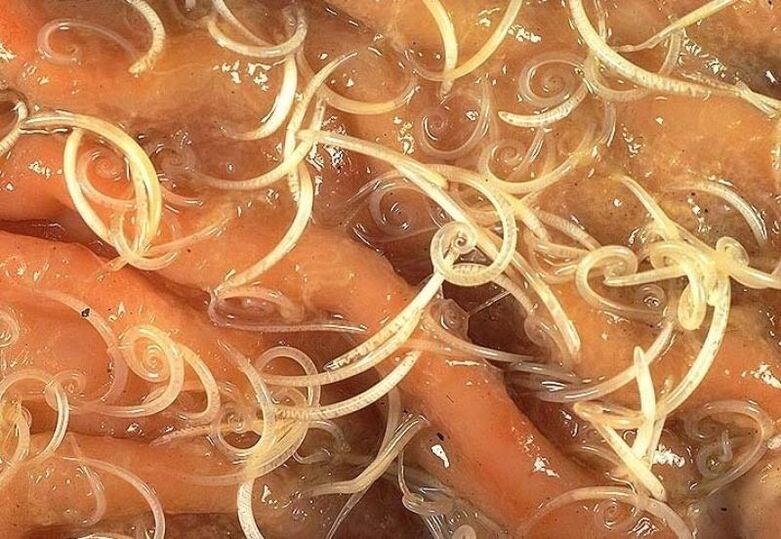
Snoes - how they look on the human body (picture of worms)
speaker- These are one of the most common human parasites, who are a nematode worm.Most often, infection with pinse worms occurs in children, but is also found in adults.
The pin is a white, small and round parasite.Individuals of female individuals have dimensions: length 8-13 mm, thickness 0.5 mm, an elongated shape and a straight tail, run at the bottom.
This feature of the female parasite tail explains its name - "cutter", from the word "Sharp".The male individual is much smaller: its length is 2-5 mm, the thickness is 0.2 mm, the tail is bent, unlike female worms.
Human occupation is named Enterobiosis, and occurs mainly with inconsistency with personal hygiene rules (insufficient hand washing).Basically, the pin worms live in the small part of the intestine and the upper part of the large intestine, but in some cases they can also migrate to organs and other organ systems.

Helminth female, after falling into the human body in an oral way, and pairing with the male representative of nematodes, migrates to the thick intestinal department, where it takes the nutrients needed for the life and maturity of eggs from unworthy food residues.
After 4 weeks, the female cutter begins to migrate to the rectum at a speed of 12 cm per hour, crawls from the anus and raises about 5000-15000 eggs in the perianal region, which after 4-6 hours are fully ripe and ready for a further life cycle.
This process may be associated with itching, which encourages an infected person to comb the anus, and thus contribute to the further spread of parasites, which fall into food from under the nails, in other people's hands (especially for children who are very close in contact with each other and not always observe the rules of personal hygiene).
Infection with pinworms worms comes from one person to a person, through dust with parasite eggs, objects affected by the patient.Bold eggs can also be transferred to food with cockroaches and flies.
Also, eggs remain in linen, clothes, beds, which explains their rapid distribution.Due to the fact that the life cycle of the worm is very fast, and the infection comes from one person to a person, it is quite difficult to get rid of parasites, as in addition to taking anthelmintic medicines, the patient's personal items are needed, and his isolation from other nematode media.
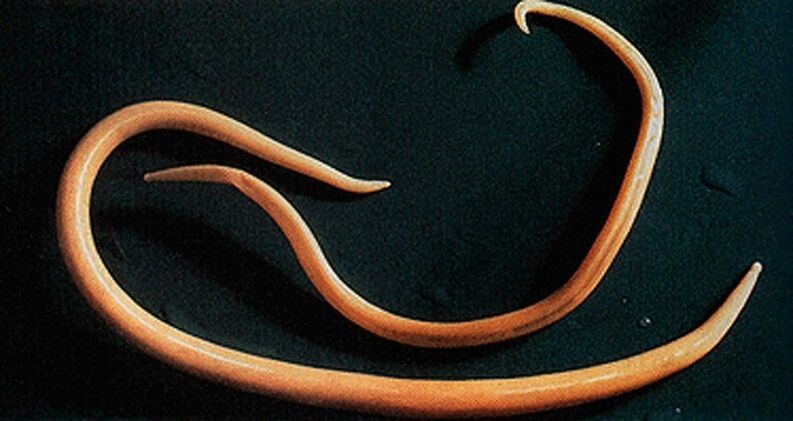
Ascarides - how they look on the human body (picture of worms)
Ascarida-This is a large parasite of a finger shape of a yellow red color, reaching an adult state of 40 cm (female) and 15-25 cm (male).Without a suction cup or other fixed equipment, ascaride can move independently to food measures.Eggs determined by the female parasite are distinguished by feces.
Acadeosis infection occurs in case of ingestion of ripe eggs along with water or vegetables and unwashed fruits on which there are particles of soil.Once the eggs penetrate the gut, the ripe larvae come out of them.
Then, by inserting into the wall of the intestine, they reach the heart according to the bloodstream, and from there they fall into the lungs.Through the pulmonary alveoli, the larvae and the ascarida through the respiratory tract penetrate the oral cavity.
In the intestinal phase of their existence, ascarids equipped with the ability of spiral movement can penetrate even the narrower holes.This parasite feature often leads to the development of quite serious complications (mechanical jaundice or pancreatitis)
After repeated swallowing, the parasite reaches the small intestine, where it develops in an adult.The worm lives for 12 months, then dies and stays with feces.In the intestines of an owner can live one or several hundred individuals.
Ascarides secreted allergens can provoke severe allergic reactions.A large number of adults can cause intestinal obstacles, and worms that have penetrated the respiratory tract sometimes cause drowning.

Vlasovsov - how they look on the human body
BlacovyvThey often live in the southern regions, as the eggs of this worm love heat.Most infections are observed in rural areas.Vlass -head eggs live on the ground.
Invasia occurs through hands, soil polluted particles, poorly washed vegetables and fruits.As a result of infection, a disease occurs - trichocephalosis.Vlashev parasitizes in the gut.This worm causes anemia, as it feeds on human blood and severe abdominal pain.
For the diagnosis of trichocephalosis, the rectum and the sigmoid intestine are examined with a special device (rectoraloscopy).Thus, the accumulations of parasites in the intestine are found.The treatment of the invasion is long, as the wounds are protected by a thick shell.
Parasite eggs are distinguished by feces, but they are very small, they cannot always be seen under a microscope.Only with a very strong invasion is it possible to detect eggs in the analysis of the feces.In shape, they look like barrels, have a brown-yellow color.
On 2 sides, the eggs are holes.What do worms look like in feces?It is very difficult to find them vivid in intestinal movements, as blazols cannot live for a long time outside the human body.Only with anthelmintic therapy can it be seen in the feces of dead white worms.
Hepatic bacon - as it looks in the human body
A parasite that causes opisthorchiasis is a flat worm that reaches a length of 7-20 mm.
In the acute phase of helminthiasis, the patient has pain in the upper abdomen, body temperature rises, vomiting, muscle pain develops, diarrhea and skin rashes are possible.The parasite larvae begin to develop as the eggs fall into fresh water (from swallowed snails).Then they penetrate the body of the fish (carp, crap, bream, roach).
Human infection occurs when you eat infected fish meat that has not suffered sufficient heat treatment.The hepatic bomb larvae from the small intestine penetrates the bile ducts and the gall bladder, fixing there with two suction cups.
The chronic course of opisthorchiasis manifests itself from the symptoms of hepatitis, inflammation of the bile ducts, cholecystitis, damaged digestion tract, nervous disorders, weakness and increased fatigue.Parasite is a movement for the development of irreversible changes, and even after its expulsion, the patient does not go through chronic inflammatory processes and functional disorders.
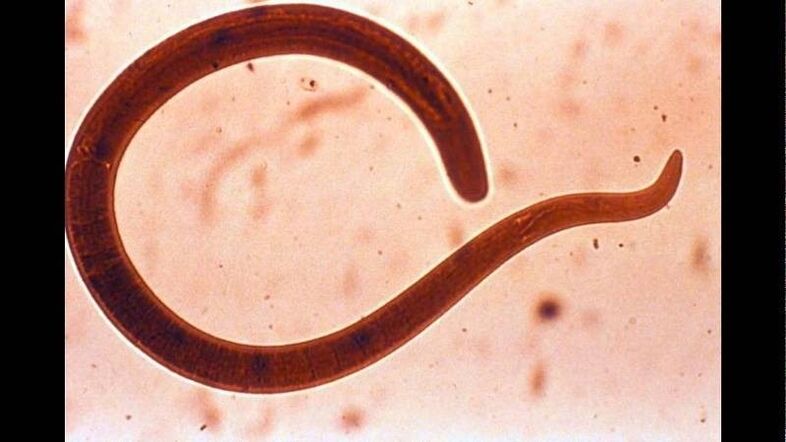
Trichinella - what does it look like in the human body (picture of worms)
The causative agent of trichinellosis is a small round helminth that reaches 2-5 mm in length.The infection occurs when the use of poorly fried meat (pork, bear cub, wild boar).By penetrating the intestine, the parasite larva in 3-4 days matures in the condition of the sexually mature individual.
The lifespan of the worm is 40 days, after which the parasite dies.By running the intestinal wall, the larvae penetrate the bloodstream and are carried into all organs of the human body, being placed in the muscles.In this case, the respiratory and facial muscles, as well as the muscles-ado-outs of the limbs, are most often affected.
In the first days after the invasion, patients complain of abdominal pain.
Then, after about 2 weeks, the body temperature rises to 39-40 s, itchy rashes appear on the skin, muscle pain develops and the face swells.
In this period, in the case of mass infection, there is a significant risk of death.After about a month, recovery occurs.The parasite is caught in a spiral form, after which it dies within two years.
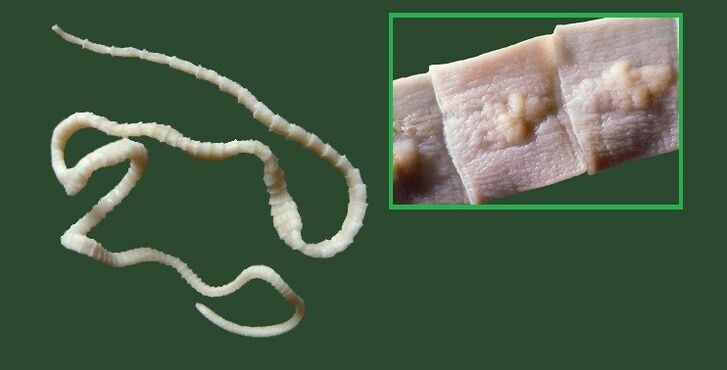
Wide tape - as it looks in the human body
This is one of the largest helminates that reaches a length of 10-20 meters.The disease caused by this parasite is called dipillobotriosis.The worm development cycle begins with freshwater fish or crustaceans.
The reach of the small intestine, the parasite is glued to its wall and for 20-25 days grows in a sexually mature individual.
The larva enters the human body, which is the last owner of a wide ribbon with infected or infected fish fillets.
Disinjobotriosis continues against the backdrop of digestive tract disorders and anemia with B12 deficiency.
Echinococcus - as it looks on a person's body
For this parasite, a person is an intermediate host.The worm parasitizes in the human body in the form of Finns.The last owner of Echinococcus is a wolf, dog or a cat.
The infection occurs in an alimentary manner in contact with animals and environmental objects, with a small portion of echinococcus eggs.Once you have entered the intestines, the oncospheres (sixth black larvae) develop from them.From the gut they penetrate the bloodstream and carry throughout the body.
The "favorite" places of worm parasitization are liver and light.Setting in these organs, the larva is transformed into a Finnish (echinococcal cyst), which, gradually increasing in size, begins to destroy the fabrics nearby.
Often, ecinococcosis in the process of diagnosis is mistaken for a tumor of benign or malignant origin.In addition to mechanical exposure (squeeze organs and blood vessels), sometimes a rupture of the ecinococcal cyst occurs.This condition can cause toxic shock or the formation of numerous new cysts.
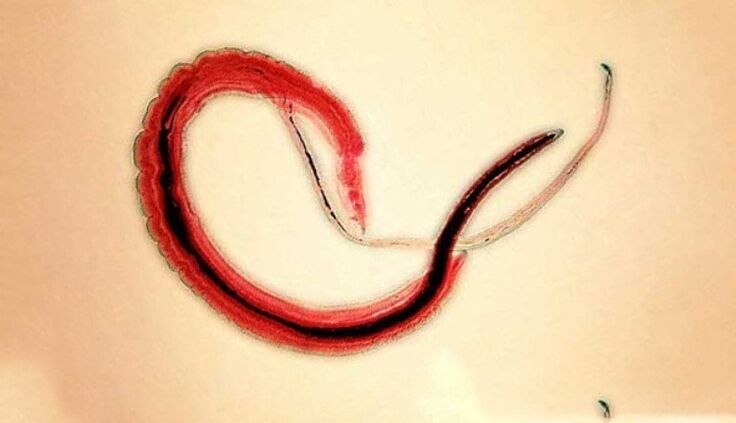
Alveokoku - as it looks in the human body
This parasite, which is considered a variety of echinococcus, is the cause of one of the most dangerous helminthias (alveococcosis), which is similar in severity with cirrhosis and liver cancer.The infection occurs with the penetration of the oncosphere (eggs with mature larvae) into the intestines.
This parasite, considered an echinococcus variety, is the cause of one of the most dangerous helminthias (alveococcosis)
There, the embryo comes out of the egg and, inserting into the intestinal wall, penetrates the bloodstream.Further, with a blood flow, the parasite spreads through all the tissues and organs of the body (most often localized in the liver).It is there that the main stage of development begins in the larvae (a bubble of very taste, laurelocyst) is formed).
The room contains an embryo head of a parasite, which continues to develop gradually.Lavrocists are very aggressive formations that grow constantly due to the growth of bubbles, as well as have the ability to grow in the liver, such as cancer metastases.
Nearby tissues due to damaged functioning of blood vessels undergo necrotic changes.By opening the nearby structures, the alveococcal forms fibrous joints with the inclusions of many taste bubbles.This condition can last for several years, with respect to which requires mandatory surgery.
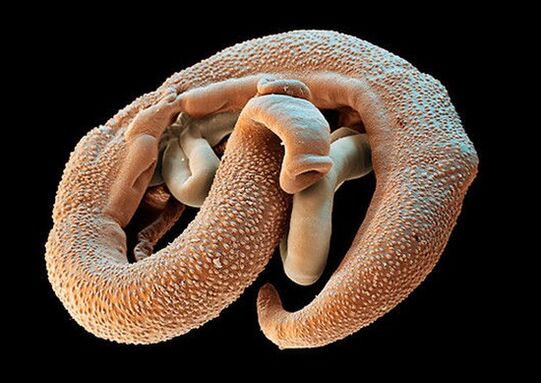
Schistosoma - as it looks in the human body
Schistosoma - a blood of blood, belongs to the class of trematodes, depending on the type it causes different skistosomosis.This is a special flat helminth, reaches 4-20 millimeters, 0.25 mm wide.The skistozy body is equipped with 2nd glasses of suction and abdominal, they are located close to each other.Schistos females are longer and thinner than men.There is a longitudinal habit in the male body, with her, he holds the female.Their eggs with a diameter of 0.1 mm, oval shape, on the surface of one of the poles are a big stroke.
Human skistosomes in the role of the last owner choose people, in their organisms they parasitize in the small veins of the colon, abdominal cavity, uterus, bladder.Worms feed on blood, partially absorb nutrients through the cuticle.Eggs with a schistos are transported to the intestine and bladder, where they ripen and come up with feces or urine.In freshwater waters, a larva - myucidius, its intermediate host - molluscs emerge from the eggs.In the body of Mollusk, metachary develops in the curial at 4-8 weeks.
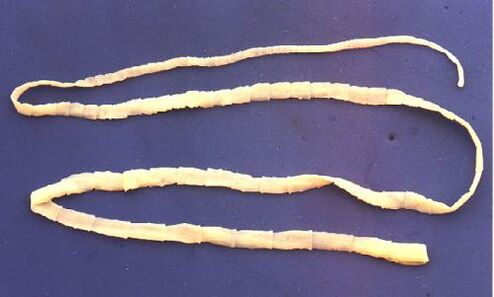
Pork color - as it looks in the human body
Pork Tapeworm, like Taurus, has 4 suction cups in the body, but in addition, the Helminth body is also equipped with a double whip of hooks.Strogil reaches two to three meters in length.Pork Tapeworm has a three -goal ovary, on each side of the uterus there are 7 to 12 branches.A characteristic feature of this helminth is the ability of segments to be dragged by the anus.After going out, their shell becomes dry and explodes, so the helminth eggs enter the outer environment.The intermediate cork master can be pigs and a person.
The main owner is a person.Intestinal parasites in humans include pork cork, helminth is located in the intestines of the patient, where he lays his eggs.The infection occurs when using invasive meat.
With which doctor to contact worms to contact
If you are suspected of infection with worms, then it is necessary to consult a medi-infectious disease specialist, Helminthologist Or a parasitologist.You can contact a specialist of infectious disease about infection with any parasitic worm or protozoa.
Or a parasitologist.You can contact a specialist of infectious disease about infection with any parasitic worm or protozoa.
You can only contact a helminthologist if the infection is suspected by parasitic worms (pinworms, ascarides, plums, opisthorchiasis, etc.).
You can contact a parasitologist in cases where the infection of the protozoa - lamblia, toxoplasma and amoebas is suspected.
Moreover, if the parasite is localized not in the intestinal or stomach lumen, but in other organs (for example, lungs, liver), then you can contact a specialist who is engaged in diagnosing and treating diseases of this organ.That is, for example, with opisthorchiasis, you can also contact a gastroenterologist or hepatologist, and with echinococcosis-so a pulmonologist.


















